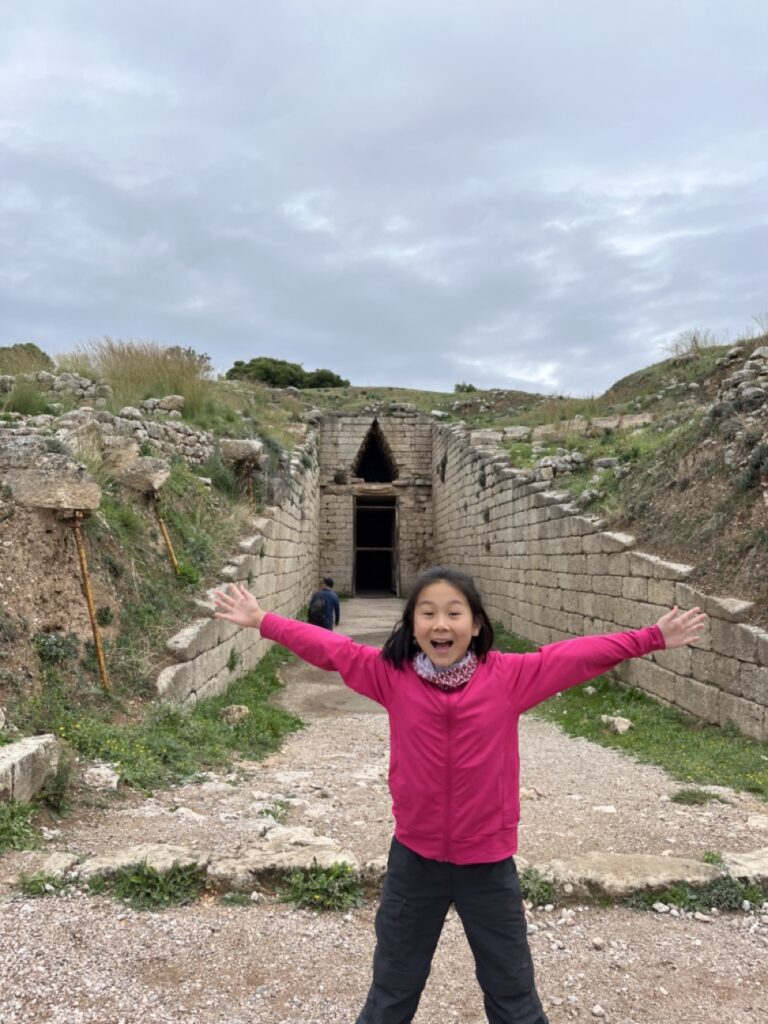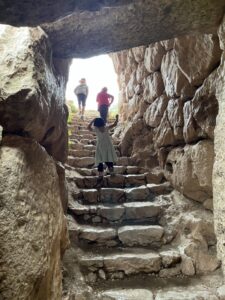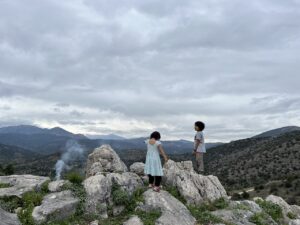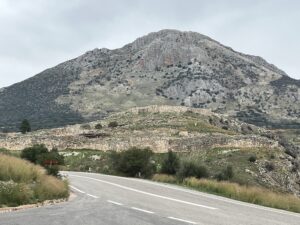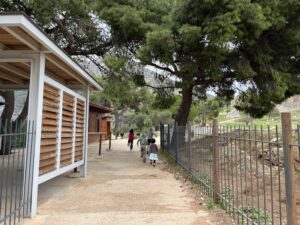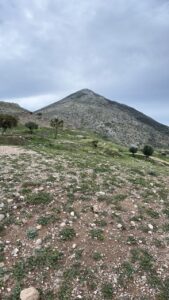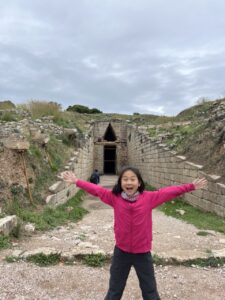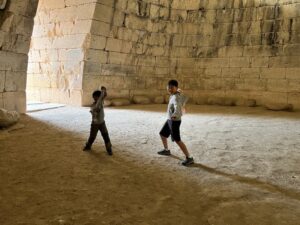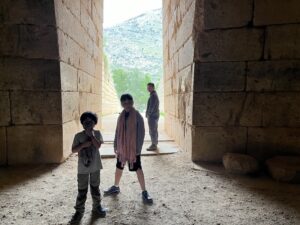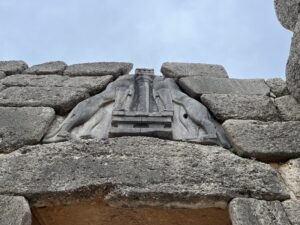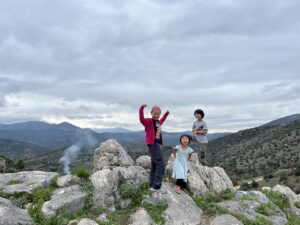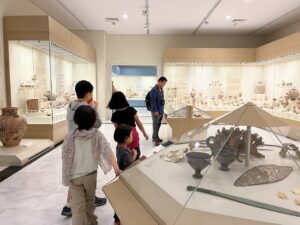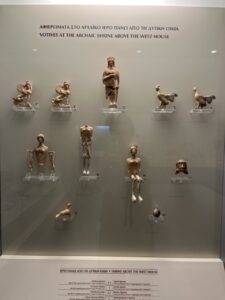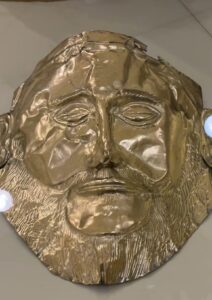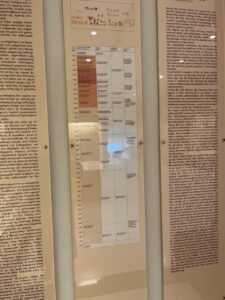To understand ancient Greek civilization and Hellenistic culture, a good place to begin is the Mycenean and Minoan civilizations. The Mycenean civilization was concentrated in the Peloponnese region and two of the most important palatial centers of the Myceneans, Mycenae and Tyrins, are in close proximity to Nafplio. The Minoan civilization is older than the Mycenean and we will explore the Minoan civilization once we reach Crete.
The two civilizations were among the greatest in Greek prehistory. They interacted, engaged in trade and influenced each other through art, architecture and religion. The intricate and graceful art and culture of the Minoans was readily embraced by the Mycenean, but eventually the Myceans would outlast the Minoans and come to dominate Crete.
The Mycenean civilization existed during the Bronze Age and lasted from about 1700 BC to 1100 BC. It was at its strongest and most influential, from the 14th to 13th centuries BC. During these 200 years, the Myceneans dominated much of the eastern Mediterranean including mainland Greece and gained influence through trade relations with other Bronze Age civilizations in Cyprus and Egypt. The culture, exploits and warriors of the Myceneans became the fodder for the timeless myths and legends of ancient Greece. Beloved heroes like Achilles and Odysseus and the dramatic stories of the Trojan War all belonged to the Myceneans.
The true origins of Mycenae is unknown. According to Greek mythology, Perseus (the hero who beheaded the gorgon Medusa) founded Mycenae. It was Perseus who instructed the Cyclopes (one-eyed giants) to build the walls of Mycenae with massive boulders, hence, the name Cyclopean walls. Perseus named the city Mycenae, and there are two possible explanations why – 1) He picked up a mushroom (myces) that led him to a fresh water spring nearby and 2) He considered it a good omen when the cap (myces) fell off of his scabbard.
Descendants of Perseus ruled Mycenae for at least three generations, ending with the rule of Eurtheus who is famous for commissioning Hercules to perform the 12 labors. After Euretheus died, Atreus became king of Mycenae.
Arguably, the most famous king of Mycenae was King Agamemnon, son of Atreus. King Agamemnon led the fight against Troy during the Trojan War, memorialized by Homer in his epic poem, the Iliad.
We arrived at the archaeological site of Mycenae to an empty parking lot and virtually the whole place to ourselves. There were a few other people around, but the site is large enough so we barely encountered them. Myceane is located on a relatively lower and flat space between two taller peaked hills, Profitis Ilias and Sara. The strategic location gave the Myceneans visibility and advantages over both the land and the sea. The archaeological site is called the Palace of Mycenae or often referred to as the acropolis or citadel. They are all referring to the same fortified walled area where the rulers lived, ruled and administrative functions took place.
In Athens, we found that it is difficult to make sense of the ruins without some basic understanding of what we are looking at. Prior to visiting the site, we did a bit of pre-learning by watching some documentaries on YouTube so we knew to look out for a few key features.
Tholos Tombs
Tholos tombs are round, bee-hive like structures built into the hillsides, where Mycenaean leaders were buried. In total, 9 Tholos tombs were discovered outside of the walls of the citadel. The tombs were constructed between 1510 BC and 1220 BC. In addition to burial sites, the tombs were believed to be storerooms where treasures were housed.
The first tholos tomb we encountered close to the entrance of the site and just before the Lions Gate, was the Tholos Tomb of Clytemnestra. The walkway leading to the entrance of the tomb is made of precisely cut and carefully stacked limestone slabs. Above the entrance of the tomb is a triangular gap in the limestone to reduce the pressure on the structural supports, much like the one found in Lions Gate. There might have been a decorative relief inside the triangle, similar to Lions Gate and there would have been wooden doors at the entrance. Inside the tomb, we could clearly see the domed construction of the tomb made using a technique called “corbelling” which involved laying the stones so each horizontal ring slightly overlapped the one below it. The final gap would be filled by a single stone slab.
The Treasury of Atreus, also known as the Tomb of Agamemnon, is the largest and best preserved Tholos tomb. The tomb strongly resembled the Tomb of Clytemnestra except that this tomb was even more massive with an even more imposing entrance, standing 5.4 meters tall. This is the only Mycenean tholos with a side chamber, believed to be the location of the burials that took place in this tomb. Despite its name, the tomb probably had nothing to do with Atreus nor with Agamemnon.
Lions Gate
The Lions Gate is the entrance to the citadel of Mycenae. The gate is adorned at the top with two relief sculptures of lionesses, which were symbols of the power of the Mycenean. In between the two lionesses is a tall column. The heads of the lionesses are believed to have been made of metal, but they have disappeared to the ages. In ancient times, there would have been a wooden door that opened inward and secured against intruders by a wooden bar.
Grave circles A and B
Close to the Lions Gate, there are two circular burial areas made up of royal graves dug into the ground. Grave Circle B (650 BC – 1550 BC) held the remains and objects of the earliest royal families of Mycenae and is estimated to about 50 years older than Grave Circle A. Similar in size to Grave Circle B, Grave Circle A (1580 BC – 1500 BC) was better preserved and held richer grave goods.
Inside the tombs, the deceased were buried with weapons, clay vessels and figurines, gold ornaments and jewelry, and funerary objects, that showed the wealth of Mycenae, the high level of craftsmanship and the importance the culture placed on sending off the dead. The most interesting objects found in the tombs were five gold funerary masks that were placed over the faces of deceased rulers. Heinrich Schliemann, the archaeologist who discovered the graves believed he had discovered the grave of King Agamemnon.
Schliemann believed that one of the golden masks belonged to King Agamemnon, thus naming it, “The Mask of King Agamemnon”. Years later, it was discovered that the mask predated the rule of Agamemnon so couldn’t have belonged to him. The mask is exhibited at the National Archaeological Museum of Athens, with a replica on display at the Archaeological Museum of Mycenae located just beside the archaeological site.
Megaron
The megaron, a great central hall, was one of the main features of Mycenean citadels. Although it was difficult to recognize in the ruins, the megaron was a rectangular room with a hearth in the center. There was a raised platform, to the right of the hearth, which held the royal throne. Surrounding the megaron were other buildings that included offices, storerooms, workshops and shrines.
Archaeological Museum of Mycenae
After visiting the archaeological site, we descended to the museum that is located near the entrance. The museum is modern but compact with only three exhibition rooms containing objects that were excavated throughout Mycenae and the area. The artifacts on display cover aspects of the Mycenean civilization including daily life, life after death, religion, art, science and trade. To walk through the actual ruins and then immediately see the excavated artifacts in the museum was almost as good as seeing the artifacts in situ. It was a similar set-up that we appreciated at the Acropolis and the corresponding Acropolis Museum in Athens.
We spent some time examining the replica of the golden funerary mask of King Agamemnon. RY and DY were more than happy to reccount the story of King Agamenmon and all of the details of the story showing his dead-set determination to win the Trojan War. Even though the mask predates the life of Agamemnon, thus could not have belonged to him, looking at the mask made us feel closer to the legendary king. It pleased us to imagine that the gold mask belonged to him. His face is wide with close-set eyes and a thin nose. The face is fully bearded with fine texturing. The mask was made by hammering thin sheets of gold onto a wooden mold.
I love comparative analysis and I am always trying to piece together what was happening in different places at any given point in time and the interplay of those events, particularly how they might have affected each other. We found a fantastic timeline on the wall of the museum that showed the various Bronze Age civilizations of Greece (Mycenaen, Minoan and Cycladic) against a timeline of Ancient Egypt. The height of the Mycenean civilization overlapped with the peak of Ancient Egypt during the 18th and 19th dynasties of the New Kingdom. The names of the pharaohs that we studied during our month in Egypt including Hatshepsut, Akhenaten, Tutankhamen and Rameses II came flooding back to my mind. It was illuminating to know that these two great civilizations developed and flourished side by side.
Around 1200 BC, 13 years after the death of Rameses II, the Mycenean civilization began to decline in tandem with the weakening of the pharaohs of Ancient Egypt’s New Kingdom. It wasn’t just the Myceneans and the Egyptians, but a near-simultaneous collapse of all of the great kingdoms clustered around the Mediterranean and Near East. The collapse of the Bronze Age decimated the Mycenaen and Minoan civilizations while the Egyptians and Babylonians managed to survive, but in a weakened state.
Mycenae suffered a series of fires and the citadel was abandoned around 1100 BC. Nobody knows for sure why the Mycenae civilization collapsed. The leading theory is that Mycenae suffered from weak rulers that led to social instability. Around the same time, neighboring Greeks invaded and destroyed the Mycenaean citadels. Other theories include Mycenae being invaded by sea raiders or befalling natural disasters, possibly earthquake, volcanic eruptions or drought. It was possibly a combination of these stressors all occurring within a short span of time that resulted in the collapse of not just the Mycenaens but of all of the Bronze Age civilizations, that was followed by a dark period of instability and technological regression. Changes of regime and collapse of civilizations isn’t such an unusual thing in the history of humankind.
Author
-

Song is the mother of four children. She and her family have stepped away from it all and in September 2023, began traveling the world while homeschooling. Song is an ABC (American born Chinese) and has an undergraduate degree from Cornell and an MBA from Harvard. She is an entrepreneur and an educator. Her hobbies include learning, traveling, reading, cooking and baking, and being with children.

